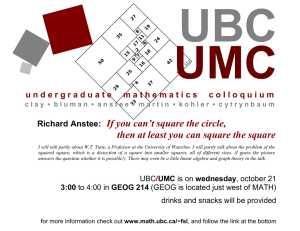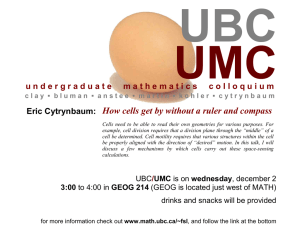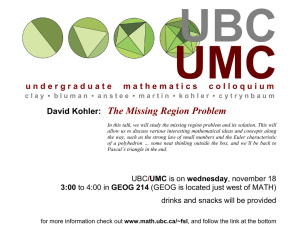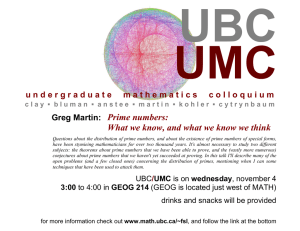Forbidden Configurations: Asymptotic bounds
advertisement
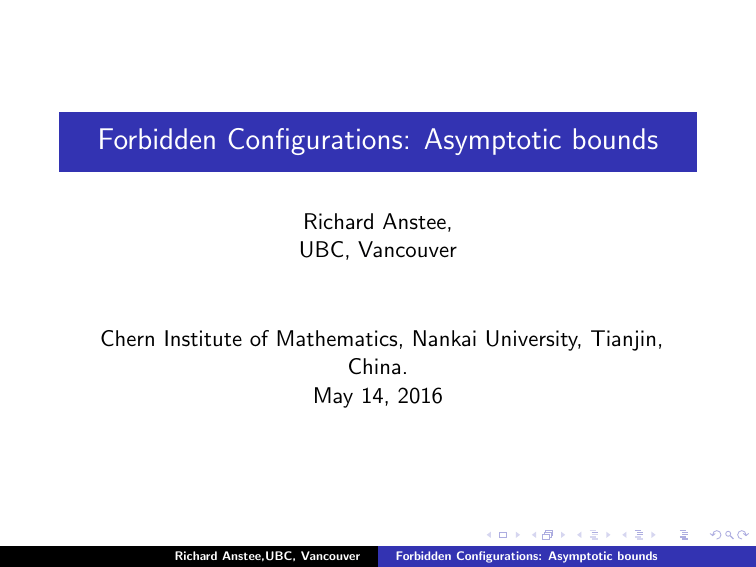
Forbidden Configurations: Asymptotic bounds
Richard Anstee,
UBC, Vancouver
Chern Institute of Mathematics, Nankai University, Tianjin,
China.
May 14, 2016
Richard Anstee,UBC, Vancouver
Forbidden Configurations: Asymptotic bounds
Introduction
I have worked with a number of coauthors in this area: Farzin
Barekat, Laura Dunwoody, Ron Ferguson, Balin Fleming, Zoltan
Füredi, Jerry Griggs, Nima Kamoosi, Steven Karp, Peter Keevash,
Linyuan Lu, Christina Koch, Connor Meehan, U.S.R. Murty,
Miguel Raggi and Attila Sali but there are works of other authors
impinging on this problem as well.
Survey at www.math.ubc.ca/∼anstee
Richard Anstee,UBC, Vancouver
Forbidden Configurations: Asymptotic bounds
Jerry isn’t tall
Richard Anstee,UBC, Vancouver
Forbidden Configurations: Asymptotic bounds
One birdwatcher and one pack animal
Richard Anstee,UBC, Vancouver
Forbidden Configurations: Asymptotic bounds
Jerry in South Carolina
Richard Anstee,UBC, Vancouver
Forbidden Configurations: Asymptotic bounds
Deynise, Malia and Jerry in South Carolina
Richard Anstee,UBC, Vancouver
Forbidden Configurations: Asymptotic bounds
Simple Matrices and Set Systems
Definition We say that a matrix A is simple if it is a (0,1)-matrix
with no repeated columns.
Richard Anstee,UBC, Vancouver
Forbidden Configurations: Asymptotic bounds
Simple Matrices and Set Systems
Definition We say that a matrix A is simple if it is a (0,1)-matrix
with no repeated columns.
i.e. if A is m-rowed then A is the incidence matrix of some family
A of subsets of [m] = {1, 2, . . . , m}.
0 0 0 1 1
A= 0 1 0 0 1
0 0 1 1 1
A = ∅, {2}, {3}, {1, 3}, {1, 2, 3}
Richard Anstee,UBC, Vancouver
Forbidden Configurations: Asymptotic bounds
Configurations
Definition Given a matrix F , we say that A has F as a
configuration written F ≺ A if there is a submatrix of A which is a
row and column permutation ofF .
1
1
1
1
1
1
0 1 0 1 1 0
0 0 1 1
F =
≺
0 0 0 0 1 1 =A
0 1 0 1
0 1 1 0 0 0
Richard Anstee,UBC, Vancouver
Forbidden Configurations: Asymptotic bounds
Our Extremal Problem
Definition We define kAk to be the number of columns in A.
Avoid(m, F) = { A : A is m-rowed simple, F 6≺ A for F ∈ F}
Richard Anstee,UBC, Vancouver
Forbidden Configurations: Asymptotic bounds
Our Extremal Problem
Definition We define kAk to be the number of columns in A.
Avoid(m, F) = { A : A is m-rowed simple, F 6≺ A for F ∈ F}
forb(m, F) = maxA {kAk : A ∈ Avoid(m, F)}
Richard Anstee,UBC, Vancouver
Forbidden Configurations: Asymptotic bounds
Our Extremal Problem
Definition We define kAk to be the number of columns in A.
Avoid(m, F) = { A : A is m-rowed simple, F 6≺ A for F ∈ F}
forb(m, F) = maxA {kAk : A ∈ Avoid(m, F)}
There are other possibilities for extremal problems for Avoid(m, F )
including maximizing the weighted sum over columns where a
column of column sum i is weighted by 1/ mi (e.g. Johnson and
Lu) or maximizing the number of 1’s .
Richard Anstee,UBC, Vancouver
Forbidden Configurations: Asymptotic bounds
A Product Construction
As with any extremal problem, the results are often motivated by
constructions, namely matrices in Avoid(m, F ). Early
investigations with Jerry Griggs and Attila Sali suggested a product
construction might be very helpful.
The building blocks of our product constructions are I , I c and T :
1 0 0 0
0 1 1 1
1 1 1 1
0 1 0 0
1 0 1 1
0 1 1 1
c
I4 =
0 0 1 0 , I4 = 1 1 0 1 , T4 = 0 0 1 1
0 0 0 1
1 1 1 0
0 0 0 1
Richard Anstee,UBC, Vancouver
Forbidden Configurations: Asymptotic bounds
Definition Given an m1 × n1 matrix A and a m2 × n2 matrix B we
define the product A × B as the (m1 + m2 ) × (n1 n2 ) matrix
consisting of all n1 n2 possible columns formed from placing a
column of A on top of a column of B. If A, B are simple, then
A × B is simple. (A, Griggs, Sali 97)
1 1 1 0 0 0 0 0 0
0 0 0 1 1 1 0 0 0
1 0 0
1 1 1
0 0 0 0 0 0 1 1 1
0 1 0 × 0 1 1 =
1 1 1 1 1 1 1 1 1
0 0 1
0 0 1
0 1 1 0 1 1 0 1 1
0 0 1 0 0 1 0 0 1
Given p simple matrices A1 , A2 , . . . , Ap , each of size m/p × m/p,
the p-fold product A1 × A2 × · · · × Ap is a simple matrix of size
m × (mp /p p ) i.e. Θ(mp ) columns.
Richard Anstee,UBC, Vancouver
Forbidden Configurations: Asymptotic bounds
Definition Given an m1 × n1 matrix A and a m2 × n2 matrix B we
define the product A × B as the (m1 + m2 ) × (n1 n2 ) matrix
consisting of all n1 n2 possible columns formed from placing a
column of A on top of a column of B. If A, B are simple, then
A × B is simple. (A, Griggs, Sali 97)
1 1 1 0 0 0 0 0 0
0 0 0 1 1 1 0 0 0
1 0 0
1 1 1
0 0 0 0 0 0 1 1 1
0 1 0 × 0 1 1 =
1 1 1 1 1 1 1 1 1
0 0 1
0 0 1
0 1 1 0 1 1 0 1 1
0 0 1 0 0 1 0 0 1
Given p simple matrices A1 , A2 , . . . , Ap , each of size m/p × m/p,
the p-fold product A1 × A2 × · · · × Ap is a simple matrix of size
m × (mp /p p ) i.e. Θ(mp ) columns.
Richard Anstee,UBC, Vancouver
Forbidden Configurations: Asymptotic bounds
The Conjecture
Definition Let x(F ) denote the largest p such that there is a
p-fold product which does not contain F as a configuration where
the p-fold product is A1 × A2 × · · · × Ap where each
c ,T
Ai ∈ {Im/p , Im/p
m/p }.
Richard Anstee,UBC, Vancouver
Forbidden Configurations: Asymptotic bounds
The Conjecture
Definition Let x(F ) denote the largest p such that there is a
p-fold product which does not contain F as a configuration where
the p-fold product is A1 × A2 × · · · × Ap where each
c ,T
Ai ∈ {Im/p , Im/p
m/p }.
Conjecture (A, Sali 05) forb(m, F ) is Θ(mx(F ) ).
In other words, we predict our product constructions with the three
building blocks {I , I c , T } determine the asymptotically best
constructions. The conjecture has now been verified in many cases.
Richard Anstee,UBC, Vancouver
Forbidden Configurations: Asymptotic bounds
The Conjecture
Definition Let x(F ) denote the largest p such that there is a
p-fold product which does not contain F as a configuration where
the p-fold product is A1 × A2 × · · · × Ap where each
c ,T
Ai ∈ {Im/p , Im/p
m/p }.
Conjecture (A, Sali 05) forb(m, F ) is Θ(mx(F ) ).
In other words, we predict our product constructions with the three
building blocks {I , I c , T } determine the asymptotically best
constructions. The conjecture has now been verified in many cases.
Attila Sali
Richard Anstee,UBC, Vancouver
Forbidden Configurations: Asymptotic bounds
Linyuan and his kids
Richard Anstee,UBC, Vancouver
Forbidden Configurations: Asymptotic bounds
An Unavoidable Forbidden Family
Theorem (Balogh and Bollobás 05) Let k be given. Then
k
forb(m, {Ik , Ikc , Tk }) ≤ 22
Richard Anstee,UBC, Vancouver
Forbidden Configurations: Asymptotic bounds
An Unavoidable Forbidden Family
Theorem (Balogh and Bollobás 05) Let k be given. Then
k
forb(m, {Ik , Ikc , Tk }) ≤ 22
We note that there is no product construction of I , I c , T so this is
consistent with the conjecture. It has the spirit of Ramsey Theory.
Richard Anstee,UBC, Vancouver
Forbidden Configurations: Asymptotic bounds
An Unavoidable Forbidden Family
Theorem (Balogh and Bollobás 05) Let k be given. Then
k
forb(m, {Ik , Ikc , Tk }) ≤ 22
We note that there is no product construction of I , I c , T so this is
consistent with the conjecture. It has the spirit of Ramsey Theory.
Theorem (A., Lu 14) Let k be given. Then there is a constant c
forb(m, {Ik , Ikc , Tk }) ≤ 2ck
Richard Anstee,UBC, Vancouver
2
Forbidden Configurations: Asymptotic bounds
An Unavoidable Forbidden Family
Theorem (Balogh and Bollobás 05) Let k be given. Then
k
forb(m, {Ik , Ikc , Tk }) ≤ 22
We note that there is no product construction of I , I c , T so this is
consistent with the conjecture. It has the spirit of Ramsey Theory.
Theorem (A., Lu 14) Let k be given. Then there is a constant c
forb(m, {Ik , Ikc , Tk }) ≤ 2ck
2
If you take all columns of column sum at most k − 1 that arise
from the k −
product Tk−1 × Tk−1 × · · · × Tk−1 then this
1-fold
2k−2
2k
yields k−1 ≈ 2 columns. A probabalistic construction in
Avoid(m, {Ik , Ikc , Tk }) has 2ck log k columns.
Richard Anstee,UBC, Vancouver
Forbidden Configurations: Asymptotic bounds
Ramsey Theory
Our proof uses lots of induction and multicoloured Ramsey
numbers: R(k1 , k2 , . . . , k` ) is the smallest value of n such than any
colouring of the edges of Kn with ` colours 1, 2, . . . , ` will have
some colour i and a clique of ki vertices with all edges of colour i.
These numbers are readily bounded by multinomial coefficients:
R(k1 , k2 , . . . , k` ) ≤
P`
i=1 ki
k1 k2 k3 · · · k`
R(k1 , k2 , . . . , k` ) ≤ `k1 +k2 +···+k`
Our first proof had something like
forb(m{, Ik , Ikc , Tk }) < R(R(k, k), R(k, k)) yielding a doubly
exponential bound.
Richard Anstee,UBC, Vancouver
Forbidden Configurations: Asymptotic bounds
Let u = R(k, k + 1, k, k, k + 1, k) < 66k+2 .
As part of our proof we show that for A ∈ Avoid(m, {Ik , Ikc , Tk }),
A cannot have a u × 2u (0,1)-submatrix of the form
0 1
a a
b b
d d
g g
k k
∗
0
c
e
h
l
∗ ∗ ∗
1 ∗ ∗
c 0 1
e f f
h i i
l m m
∗
∗
∗
0
j
n
∗
∗
∗
1
j
n
∗
∗
∗
∗
0
o
∗
∗
∗
∗
1
o
∗
∗
∗
∗
∗
0
∗
∗
∗
∗
∗
1
One can interpret the entries of the matrix as 1 × 2 blocks yielding
a u × u matrix with the blocks below the diagonal either 0 0 or
1 1 with blocks on the diagonal 0 1 and arbitrary (0,1)-blocks
above the diagonal.
We consider a colouring of the complete graph Ku with edge i, j
getting a colour based on the entries in the block j, i and the block
i, j.
Richard Anstee,UBC, Vancouver
Forbidden Configurations: Asymptotic bounds
We consider a colouring of the complete graph Ku with edge i, j
getting a colour based on the entries in the block j, i and the block
i, j.
There are 6 colours to consider
0 0
1 ∗
∗ 1
1 1
0 ∗
∗ 0
,
,
,
,
,
0 0
0 0
0 0
1 1
1 1
1 1
We are able to show that u < R(k, k + 1, k, k, k + 1, k) and so we
get a singly exponential bound on u ≤ 66k+2 . The proof has more
to do than this but this is a critical step.
Richard Anstee,UBC, Vancouver
Forbidden Configurations: Asymptotic bounds
We say that the edge i, j is colour
1 ∗
0 0
if we have 0 0 in entry
(j, i) and 1 ∗ in entry (i, j):
i
01
i
j
1∗
..
j
.
00
01
Now consider a clique of size k + 1 of colour
0
0
0
0
0
1
0
0
0
0
1
0
0
0
0
∗
1
0
0
0
1
1
0
0
0
∗
∗
1
0
0
Richard Anstee,UBC, Vancouver
1
1
1
0
0
∗
∗
∗
1
0
1
1
1
1
0
1 ∗
:
0 0
∗
∗
∗ yields Tk
∗
1
Forbidden Configurations: Asymptotic bounds
We say that the edge i, j is colour
1 ∗
0 0
if we have 0 0 in entry
(j, i) and 1 ∗ in entry (i, j):
i
01
i
j
1∗
..
j
.
00
01
Now consider a clique of size k + 1 of colour
0
0
0
0
0
1
0
0
0
0
1
0
0
0
0
∗
1
0
0
0
1
1
0
0
0
∗
∗
1
0
0
Richard Anstee,UBC, Vancouver
1
1
1
0
0
∗
∗
∗
1
0
1
1
1
1
0
1 ∗
:
0 0
∗
∗
∗ yields Tk
∗
1
Forbidden Configurations: Asymptotic bounds
We say that the edge i, j is colour
∗ 1
0 0
if we have 0 0 in entry
(j, i) and 1 ∗ in entry (i, j):
i
01
i
j
∗1
..
j
.
00
01
Now consider a clique of size k of colour
0
0
0
0
0
1
0
0
0
0
∗
0
0
0
0
1
1
0
0
0
∗
∗
0
0
0
1
1
1
0
0
Richard Anstee,UBC, Vancouver
∗
∗
∗
0
0
1
1
1
1
0
∗
∗
∗
∗
0
∗ 1
:
0 0
1
1
1 yields Tk
1
1
Forbidden Configurations: Asymptotic bounds
We say that the edge i, j is colour
∗ 1
0 0
if we have 0 0 in entry
(j, i) and 1 ∗ in entry (i, j):
i
01
i
j
∗1
..
j
.
00
01
Now consider a clique of size k of colour
0
0
0
0
0
1
0
0
0
0
∗
0
0
0
0
1
1
0
0
0
∗
∗
0
0
0
1
1
1
0
0
Richard Anstee,UBC, Vancouver
∗
∗
∗
0
0
1
1
1
1
0
∗
∗
∗
∗
0
∗ 1
:
0 0
1
1
1 yields Tk
1
1
Forbidden Configurations: Asymptotic bounds
We say that the edge i, j is colour
0 0
0 0
if we have 0 0 in entry
(j, i) and 0 0 in entry (i, j):
i
01
i
j
00
..
j
.
00
01
Now consider a clique of size k of colour
0
0
0
0
0
1
0
0
0
0
0
0
0
0
0
0
1
0
0
0
0
0
0
0
0
0
0
1
0
0
Richard Anstee,UBC, Vancouver
0
0
0
0
0
0
0
0
1
0
0
0
0
0
0
0 0
:
0 0
0
0
0 yields Ik
0
1
Forbidden Configurations: Asymptotic bounds
We say that the edge i, j is colour
0 0
0 0
if we have 0 0 in entry
(j, i) and 0 0 in entry (i, j):
i
01
i
j
00
..
j
.
00
01
Now consider a clique of size k of colour
0
0
0
0
0
1
0
0
0
0
0
0
0
0
0
0
1
0
0
0
0
0
0
0
0
0
0
1
0
0
Richard Anstee,UBC, Vancouver
0
0
0
0
0
0
0
0
1
0
0
0
0
0
0
0 0
:
0 0
0
0
0 yields Ik
0
1
Forbidden Configurations: Asymptotic bounds
Thus if we have u = R(k, k + 1, k, k, k + 1, k) then we find a copy
of Ik or Ikc or Tkc . a contradiction to A ∈ Avoid(m, {Ik , Ikc , Tk }).
We conclude u < R(k, k + 1, k, k, k + 1, k) and so we get a singly
exponential bound u ≤ 66k+2 = 2ck .
Richard Anstee,UBC, Vancouver
Forbidden Configurations: Asymptotic bounds
Multiple Columns
s
z
}|
{
Let s · F denote [F |F | · · · |F ].
Theorem (A, Füredi 86) Let s ≥ 2 be given. Let Kk denote the
k × 2k simple matrix of all possible (0,1)-columns on k rows. Then
forb(m, s · Kk ) is Θ(mk ).
Theorem (A, Lu 14) Let s ≥ 2 be given. Then there exists a
(largish) constant C with
forb(m, {s · Ik , s · Ikc , s · Tk }) ≤ (4s − 3)m + C
.
Richard Anstee,UBC, Vancouver
Forbidden Configurations: Asymptotic bounds
Exact bounds and asymptotic bounds
Let
1
1
F =
0
0
0
0
1
1
Theorem (Frankl, Füredi, Pach 87) forb(m, F ) =
i.e. forb(m, F ) is Θ(m2 ).
m
2
+ 2m − 1
Theorem (A. and Lu 13) Let s be given. Then forb(m, s · F ) is
Θ(m2 ).
Note x(F ) = 2 = x(s · F ) so this is consistent with conjecture
Problem Let α be given and imagine mα as an honourary integer.
Show forb(m, mα · F ) is Θ(m2+α ).
We can only prove that forb(m, mα · F ) is O(mmin{3+α,2+2α} ).
Richard Anstee,UBC, Vancouver
Forbidden Configurations: Asymptotic bounds
We say a matrix with entries in {0, 1, . . . , r − 1} is an r -matrix.
An r -matrix is simple if there are no repeated columns.
forb(m, r , F) = max{kAk : A is a simple r -matrix, F 6≺ A, F ∈ F}
Richard Anstee,UBC, Vancouver
Forbidden Configurations: Asymptotic bounds
We say a matrix with entries in {0, 1, . . . , r − 1} is an r -matrix.
An r -matrix is simple if there are no repeated columns.
forb(m, r , F) = max{kAk : A is a simple r -matrix, F 6≺ A, F ∈ F}
Theorem (A, Lu 14) Given r there exists a constant cr so that
2
forb(m, Tk (r )) ≤ 2cr k .
Richard Anstee,UBC, Vancouver
Forbidden Configurations: Asymptotic bounds
T (3)\Tk (2) =
k
1 2 ··· 2
2 1 ··· 2
.. .. . .
. .
.
,
2 2 ···
1
2 1 ···
1 2 ···
.. .. . .
.
. .
1 1 ···
1
1
,
2
0
0
,
0
0 0 ···
2 0 ···
.. .. . .
.
. .
2 2 ···
0 2 ···
2 0 ···
.. .. . .
.
. .
2 2 ···
2 2 ···
0 2 ···
.. .. . .
.
. .
0 0 ···
1 1 ···
2 1 ···
.. .. . .
.
. .
2 2 ···
2
2
,
0
2
2
,
2
1
1
.
1
2 0 ···
0 2 ···
.. .. . .
.
. .
0 0 ···
2 2 ···
1 2 ···
.. .. . .
.
. .
1 1 ···
0
0
,
2
2
2
,
2
Problem Let F be a family of (0, 1)-matrices.
forb(m, (Tk (3)\Tk (2) ∪ F)) is Θ(forb(m, F)).
Richard Anstee,UBC, Vancouver
Forbidden Configurations: Asymptotic bounds
THANKS to Linyuan and all those who helped in organizing this
wonderful event.
And of course Happy Birthday to Jerry!!
Richard Anstee,UBC, Vancouver
Forbidden Configurations: Asymptotic bounds
